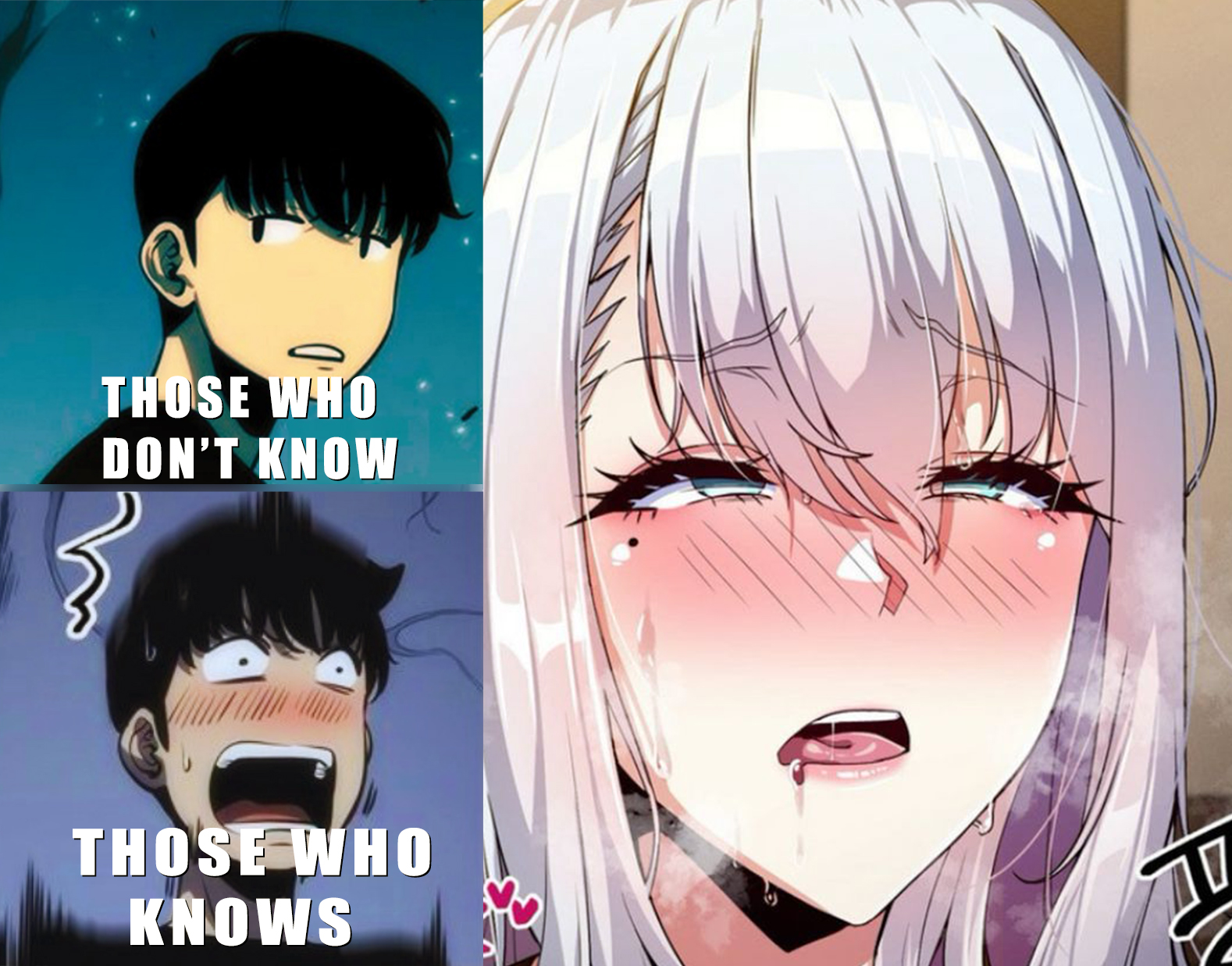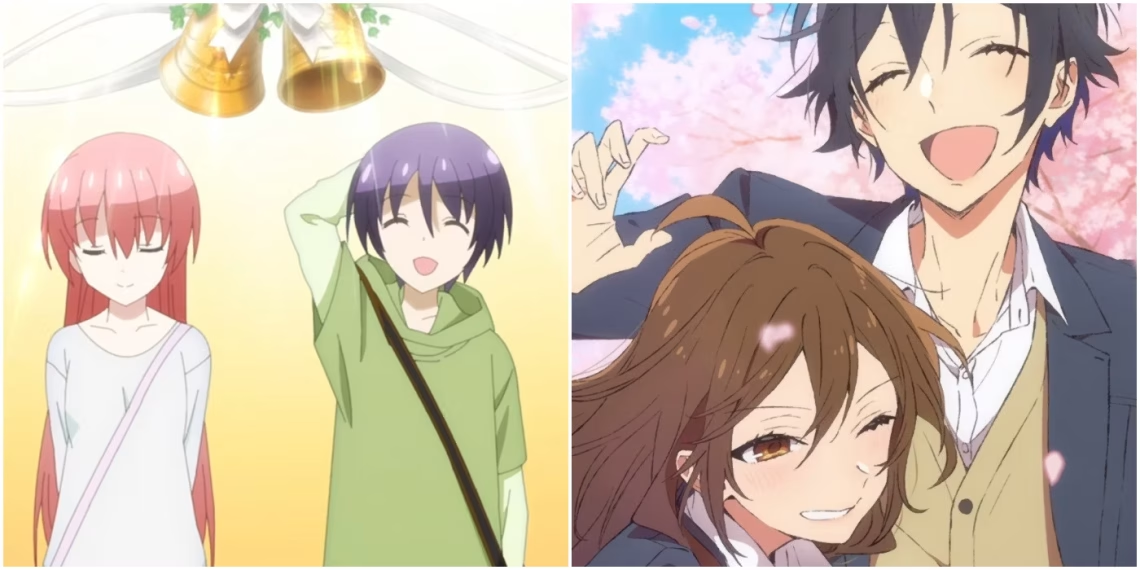There’s a wide array of anime genres out there, catering to various tastes—from action-packed adventures with mechas battling evil to heartwarming stories focusing on everyday life. While many anime get viewers’ adrenaline pumping, there’s a special place for those that offer a more relaxing and wholesome experience, often falling under the comedy, romance, and slice-of-life categories.
These feel-good anime offer a refreshing break from high-stakes narratives and intense action. Instead of epic battles, they present everyday challenges and humorous misunderstandings. Viewers are drawn to the sincere relationships that develop among the characters, often tackling obstacles together in heartwarming ways.
Contrary to popular belief, not all anime are filled with mature themes and emotional roller coasters. There’s a significant number of shows that explore wholesome topics, leaving viewers with a warm and fuzzy feeling. The sheer variety in the anime world ensures there’s something for everyone, and these wholesome series provide a sense of joy and tranquility that’s unique to their genre.
As more wholesome anime series continue to be added to the mix, fans can look forward to discovering more shows that evoke feelings of happiness and contentment, offering a different kind of satisfaction compared to other genres in the anime universe.
10. School Babysitters
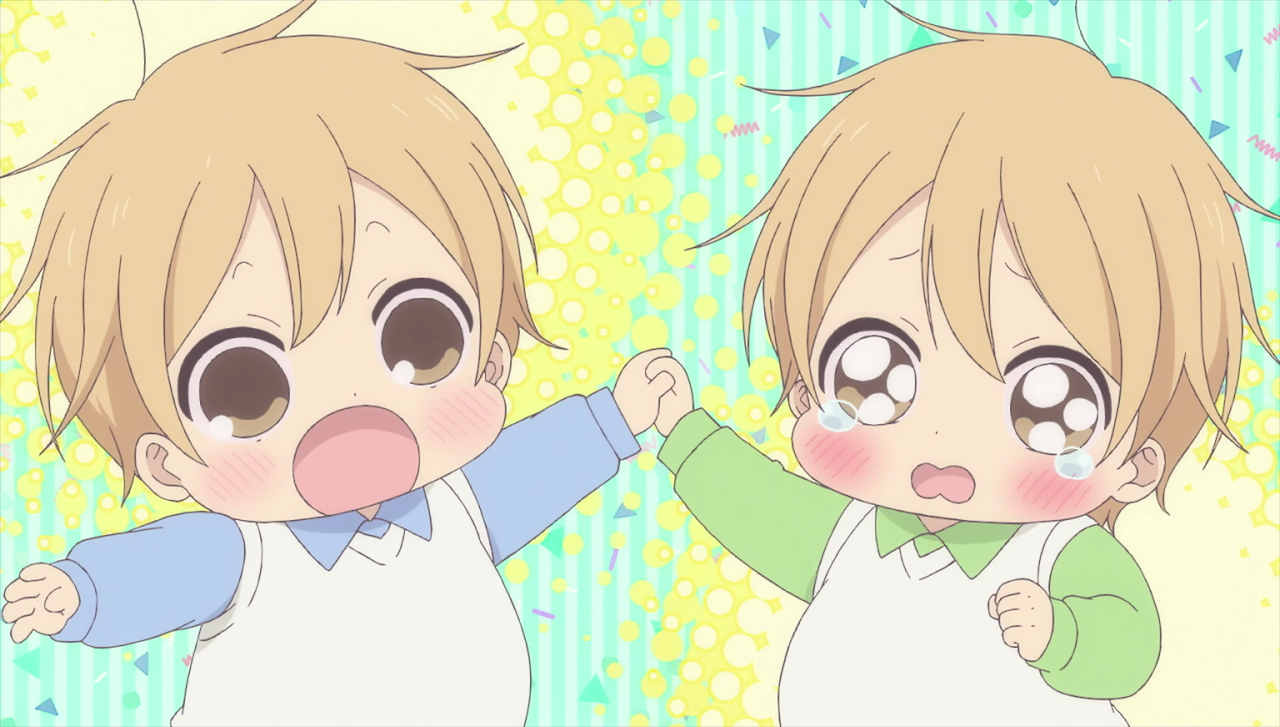
School Babysitters unfolds as a heartwarming comedic slice-of-life anime centered around three brothers who find themselves orphaned after the sudden loss of their parents. Left homeless, the two older brothers, high school students, and their preschool siblings are taken in by the compassionate chairwoman of an academy.
In exchange for free housing and schooling, the brothers are tasked with assisting in the school’s daycare center. What ensues is a touching narrative that celebrates the importance of caring for one another. Despite the chairwoman’s initially stern demeanor, her motherly instincts shine through as she nurtures and supports the boys.
At the heart of the anime is the bond between the siblings, as the older brothers prioritize their younger sibling’s well-being above all else. Through their selfless acts of compassion and support, School Babysitters reinforces the values of empathy, charity, and selflessness.
As viewers witness the characters’ genuine acts of kindness and camaraderie, the anime serves as a poignant reminder of the power of love and familial bonds. It’s a wholesome and uplifting watch that resonates with audiences, leaving a lasting impression of the beauty found in caring for one another.
School Babysitters (or “Gakuen Babysitters” in Japanese) is a heartwarming slice-of-life anime series based on the manga by Hari Tokeino. The anime adaptation was produced by Brain’s Base and aired from January to June 2018, comprising 12 episodes.
It tells the story of Ryuuichi Kashima, a high school student who becomes a babysitter to support himself and his younger brother Kotarou after their parents tragically pass away.
The story begins with Ryuuichi and Kotarou being taken in by the chairwoman of Morinomiya Academy after their parents’ plane crashes. To repay the chairwoman’s kindness, Ryuuichi agrees to work at the academy’s daycare center, taking care of the children of the faculty and staff while attending school.
As Ryuuichi adapts to his new role as a babysitter, he encounters various challenges and heartwarming moments while caring for the energetic and diverse group of toddlers.

Each episode of “School Babysitters” typically revolves around Ryuuichi’s interactions with the children, exploring themes of family, friendship, and the responsibilities of parenthood. The show also goes into the lives of the other daycare staff, including the kind-hearted yet strict teacher, Yayoi, and the eccentric but caring nursery teacher, Hayato Kamitani.
The characters in “School Babysitters” are well-developed and endearing, with each child having their own unique personality traits and quirks. Kotarou, Ryuuichi’s little brother, is particularly adorable and forms a strong bond with the other daycare kids.
Ryuuichi himself undergoes significant growth throughout the series, learning valuable life lessons from his experiences as a babysitter and gradually becoming a parental figure to the children.
At its core, “School Babysitters” explores themes of family, resilience, and the importance of emotional support. The series effectively conveys the challenges and rewards of parenthood through Ryuuichi’s interactions with the children, highlighting the joys of watching them grow and learn.
The animation quality in “School Babysitters” is consistent and appealing, with bright and cheerful visuals that complement the lighthearted tone of the series. The character designs are expressive, and the animation effectively captures the energy and innocence of the daycare children.
“School Babysitters” received positive reviews from both viewers and critics alike for its heartwarming storytelling and lovable characters.. The series resonated with audiences for its emotional depth and wholesome depiction of family dynamics.
Many viewers praised the show for its ability to evoke both laughter and tears, making it a standout title in the slice-of-life genre. As a fan of slice-of-life anime, “School Babysitters” quickly became one of my favorite series due to its engaging characters and touching narrative.
The show masterfully balances comedy and drama, delivering heartfelt moments without becoming overly sentimental. I appreciated how the series tackled complex themes such as grief and resilience with sensitivity and optimism.
School Babysitters”is a delightful anime that celebrates the joys of family and the bonds that form between individuals who care for one another. It’s a must-watch for anyone looking for a heartwarming story filled with lovable characters and meaningful life lessons.
Whether you’re a fan of slice-of-life anime or simply enjoy stories about the joys of childhood, “School Babysitters” is sure to leave a lasting impression.
9. Princess Jellyfish
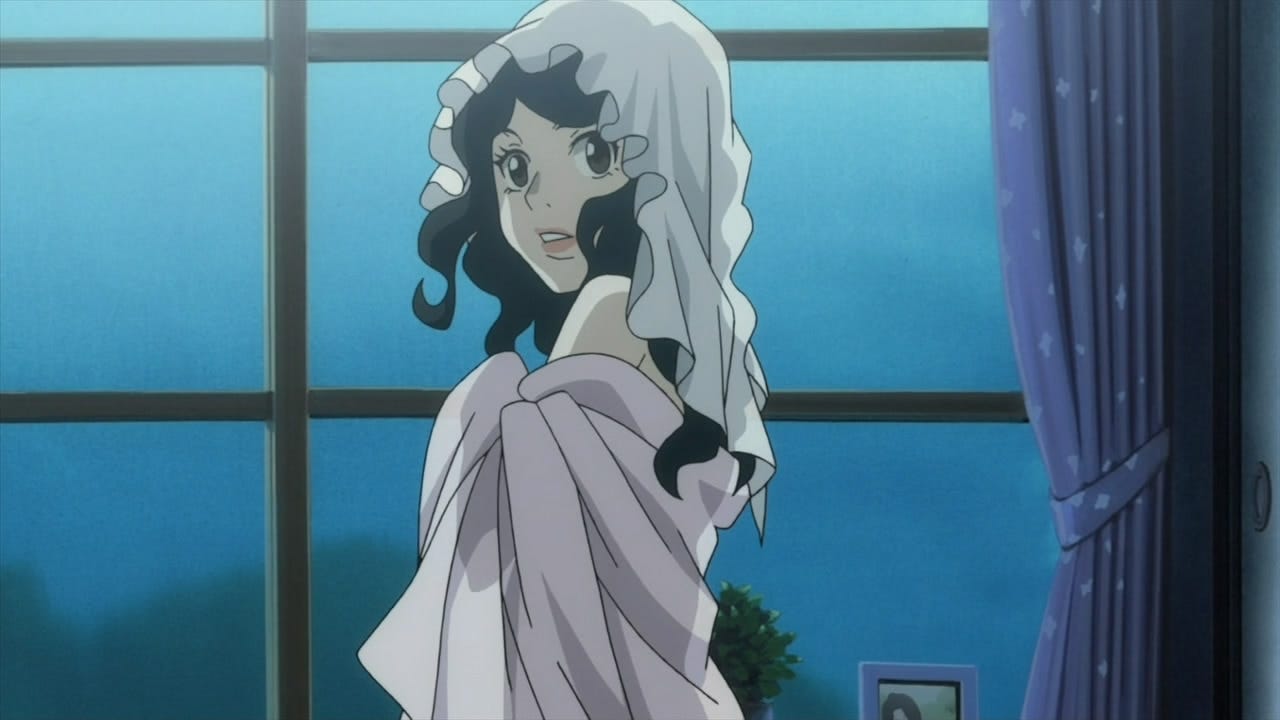
Princess Jellyfish offers a delightful blend of romantic comedy, coming-of-age, and slice-of-life elements, centered around the socially awkward Sisterhood and their journey of self-discovery. At the heart of the story is Tsukimi Kurashita, a young woman with a deep love for jellyfish stemming from cherished memories with her late mother.
Enter Kuranosuke, a charismatic individual who challenges societal norms by cross-dressing as a woman. Through his unexpected friendship with Tsukimi, he introduces her to the world of fashion, despite the Sisterhood’s apprehension towards attractive individuals. Together, they join forces with the Sisterhood to save their beloved housing district from demolition.
The anime unfolds with comedic chaos and endearing character dynamics, highlighting the importance of self-love, confidence, and acceptance. As the characters navigate their personal struggles and fears, they learn valuable lessons about embracing their true selves and letting go of preconceived notions.
Kuranosuke serves as a catalyst for Tsukimi’s growth, offering guidance in matters of love, ambition, and style. Meanwhile, Tsukimi imparts lessons of empathy, the power of memories, and the value of accepting help from others.
Through its humor and heartfelt moments, Princess Jellyfish delivers a powerful message about the beauty of individuality and the strength found in embracing one’s true identity. It’s a touching and uplifting anime that celebrates the journey toward self-discovery and the bonds formed through shared experiences and acceptance.

Princess Jellyfish (Kuragehime) is a nice and unique manga series written and illustrated by Akiko Higashimura. It was serialized in Kiss magazine from 2008 to 2017 and later adapted into an anime series and a live-action film. The story revolves around a group of socially awkward women living in a communal residence called Amamizukan in Tokyo’s trendy Shibuya district.
The protagonist is Tsukimi Kurashita, an otaku who is obsessed with jellyfish and lives a secluded life with a group of fellow female otaku. They all share a fear of stylish and fashionable people, referring to them as “Stylish” individuals.
One day, Tsukimi encounters a stunning and fashionable woman, Kuranosuke Koibuchi, who rescues a jellyfish from a pet shop. Tsukimi later discovers that “Kuranosuke” is actually a cross-dressing young man and the son of a powerful political family.
As Tsukimi and Kuranosuke’s friendship deepens, he becomes involved in helping the women of Amamizukan with their various endeavors, including saving their residence from redevelopment. The story explores themes of friendship, self-discovery, acceptance, and the clash between individuality and societal norms.
“Princess Jellyfish” is a story about self-acceptance and breaking societal norms. Each character in Amamizukan struggles with their insecurities and fears, often due to societal pressure and their own perceptions of beauty and social expectations. Tsukimi’s journey is central to the narrative, as she learns to embrace herself and her passions while challenging her own preconceptions about others.
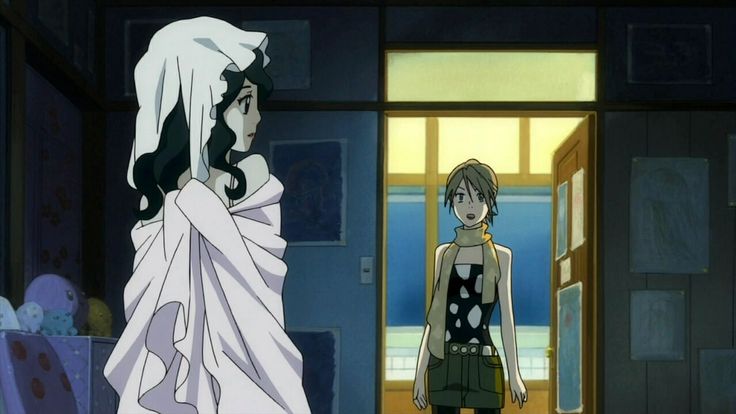
The series cleverly critiques gender roles and expectations, as seen through Kuranosuke’s character. His cross-dressing challenges traditional ideas of masculinity and femininity, highlighting the fluidity and complexity of gender identity.
Moreover, “Princess Jellyfish” explores the power of friendship and camaraderie. The bond between Tsukimi and her housemates grows stronger as they face external challenges together, such as preserving their home and pursuing their dreams. The characters’ quirks and vulnerabilities make them relatable and endearing, drawing readers into their world.
Akiko Higashimura’s art style is distinctive, characterized by expressive character designs and detailed backgrounds. The manga’s visual humor enhances the storytelling, adding depth to the characters’ emotions and interactions. Higashimura’s skillful use of visual metaphors, particularly related to jellyfish imagery, enriches the thematic exploration of identity and transformation.
“Princess Jellyfish” received critical acclaim for its engaging narrative, well-developed characters, and thought-provoking themes. It resonated with readers for its portrayal of marginalized individuals finding strength in unity and embracing their uniqueness. The series gained a dedicated fanbase and contributed to broader discussions about gender identity and societal expectations in manga and anime.
In addition to the manga, “Princess Jellyfish” was adapted into a 2010 anime television series produced by Brain’s Base. The anime faithfully captures the manga’s charm and humor while further bringing the characters to life through voice acting and animation.
A live-action film adaptation was released in 2014, receiving positive reviews for its performances and faithfulness to the source material. Princess Jellyfish is a delightful and insightful manga that skillfully combines humor, drama, and social commentary.
Through its endearing characters and heartfelt storytelling, the series encourages readers to embrace their individuality and challenge societal norms. Akiko Higashimura’s masterful blend of art and narrative creates a world that is both fantastical and relatable, making “Princess Jellyfish” a standout work in contemporary manga.
8. Horimiya
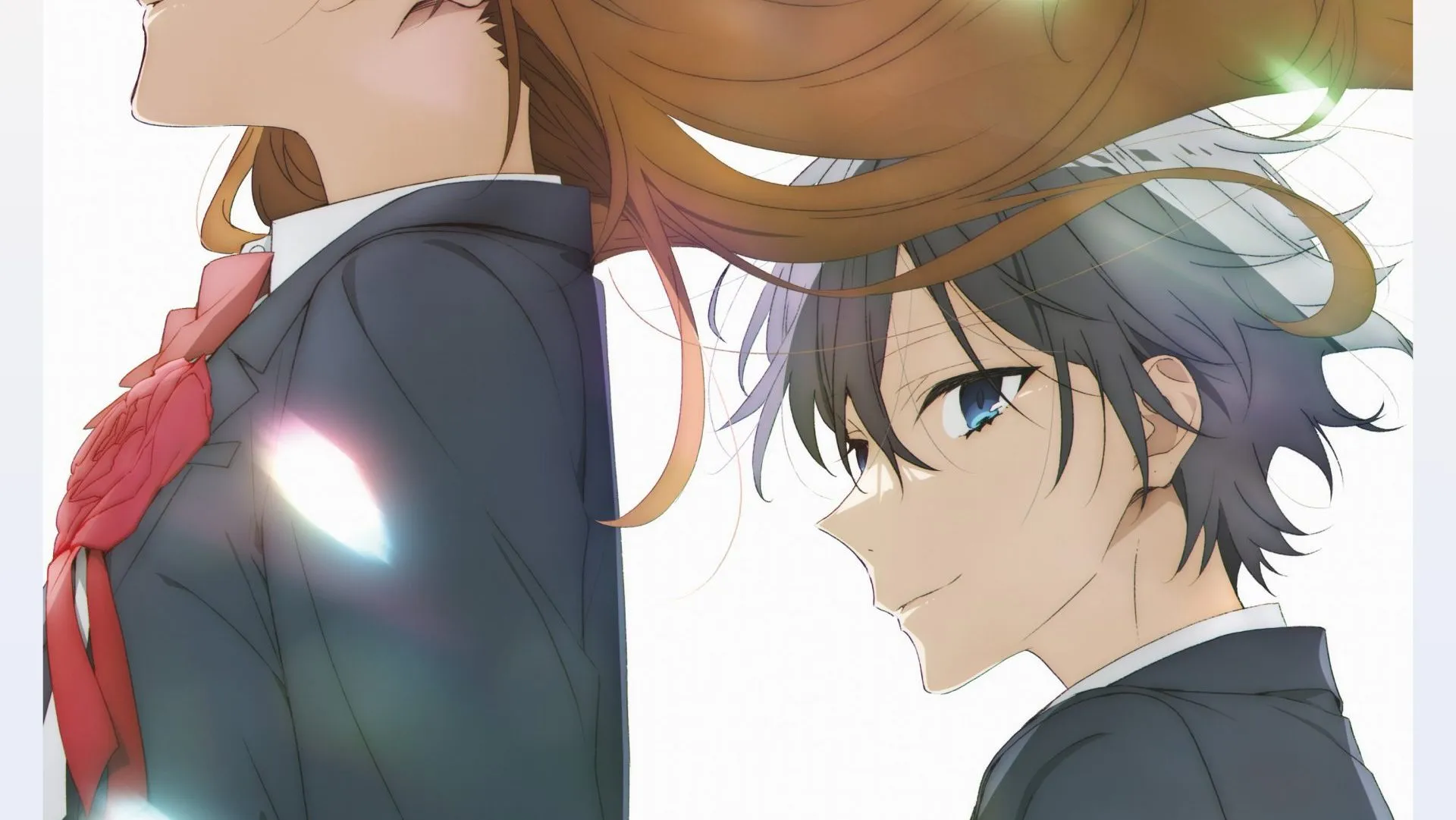
Hori-san to Miyamura-kun, also known as Horimiya presents a charming romantic comedy that explores the stark contrast between the public and private personas of its two main characters.
Kyoko Hori, a bright and popular student at school, leads a more subdued life at home, while Izumi Miyamura, her gloomy classmate, reveals a surprising array of tattoos and piercings outside of school. As they agree to keep each other’s secrets, their bond deepens as they discover commonalities and grow closer.
The anime seamlessly blends comedy, romance, and relaxation, offering viewers a delightful and entertaining experience. At its core, Horimiya champions the importance of authenticity and self-acceptance, urging individuals to embrace their true selves regardless of societal expectations.
Through the blossoming relationship between Hori and Miyamura, the anime imparts valuable lessons on honesty, self-love, friendship, and the importance of opening up to others.
In a world often filled with negativity and judgment, Horimiya serves as a refreshing and uplifting reminder to prioritize positivity and authenticity. By showcasing the transformative power of genuine connections and self-acceptance, the anime encourages viewers to let go of insecurities and embrace life with an open heart and mind.
Ultimately, Horimiya is a beacon of light in the looks of romantic comedy, offering a heartwarming and relatable narrative that inspires viewers to cultivate meaningful relationships, cherish their true selves, and embrace the beauty of authenticity.

Horimiya is a popular romantic comedy manga series written by HERO and illustrated by Daisuke Hagiwara. Originally starting as a webcomic in 2007, it later transitioned to a serialized manga series that ran from 2011 to 2021. Horimiya gained significant popularity for its endearing characters, heartfelt storytelling, and exploration of themes like friendship, identity, and love.
The story revolves around two high school students, Kyoko Hori and Izumi Miyamura. At school, Hori is known as a popular and sociable girl, while Miyamura is perceived as a quiet and introverted otaku. However, outside of school, their true personalities and lives are quite different from their public images.
Hori is revealed to be a responsible and caring girl who takes care of her younger brother and manages the household chores, all while keeping up with her studies and maintaining a fashionable appearance. On the other hand, Miyamura is a soft-spoken and gentle boy with multiple piercings and tattoos hidden beneath his school uniform.
The two characters meet unexpectedly outside of school, discovering each other’s hidden sides. As they spend more time together, they form a close bond and begin to understand and support each other’s struggles and insecurities. The series follows their evolving relationship and the challenges they face both individually and as a couple.

One of the central themes of Horimiya is the idea of self-discovery and acceptance. Both Hori and Miyamura struggle with their self-image and societal expectations, and their relationship allows them to embrace their true selves without fear of judgment.
The series also explores the complexities of friendship, family dynamics, and romantic relationships, depicting realistic interactions and emotions.
Another key theme in Horimiya is the importance of communication and understanding in relationships. Hori and Miyamura’s bond deepens as they learn to open up to each other and share their vulnerabilities. The manga portrays love not only as a romantic feeling but also as a source of support and growth between individuals.
Characters:
- Kyoko Hori: The main female protagonist, Hori appears as a popular and outgoing student at school but is actually responsible for taking care of her household and younger brother due to her parents’ absence.
- Izumi Miyamura: The main male protagonist, Miyamura is a quiet and reserved student at school, known for his unkempt appearance. Outside of school, he reveals his true self as a kind-hearted boy with piercings and tattoos.
- Yoshikawa Yuki: Hori’s best friend, Yuki is cheerful and supportive, often providing comic relief in the story.
- Tooru Ishikawa: Miyamura’s friend and a classmate, Ishikawa is a popular and easygoing student with a playful personality.
- Kyouko Hori’s Family: Hori’s family members, including her younger brother Souta and her absent-minded father, play important roles in Hori’s life and add depth to her character.

Daisuke Hagiwara’s art style is clean, expressive, and visually appealing. The character designs are distinct, and the artwork effectively conveys emotions and comedic moments. Hagiwara’s use of paneling and visual storytelling enhances the narrative flow, making the series engaging and easy to follow.
Horimiya received positive reviews from both readers and critics for its relatable characters, genuine relationships, and heartwarming moments. It gained a large fanbase, particularly among fans of romance and slice-of-life genres.
The series was praised for its realistic portrayal of teenage life and its ability to balance lighthearted humor with poignant emotional moments.

In addition to the manga, Horimiya was adapted into an anime series in 2021 by CloverWorks. The anime faithfully adapts the manga’s storyline and captures the essence of the characters and their relationships. It received widespread acclaim for its animation quality, voice acting, and faithfulness to the source material.
Horimiya is a touching and beautifully crafted manga series that explores themes of identity, friendship and love with sincerity and depth. HERO’s storytelling and Daisuke Hagiwara’s artwork create a compelling narrative that resonates with readers of all ages.
Whether you’re a fan of romance, slice-of-life, or coming-of-age stories, Horimiya offers a heartwarming and enjoyable reading experience that leaves a lasting impression.
7. Laid-Back Camp

Laid-Back Camp captures the serene essence of camping, offering viewers a tranquil escape from the hustle and bustle of city life. Set against the backdrop of nature’s playgrounds, the anime invites audiences to immerse themselves in the beauty of the great outdoors and the simple pleasures of camping.
What sets Laid-Back Camp apart is its ability to weave together moments of relaxation and camaraderie as characters look on their camping adventures. Each episode unfolds with a sense of serenity, allowing viewers to vicariously experience the joys of outdoor exploration and the bonds formed amidst nature’s embrace.
The anime’s charm lies in its characters, who evolve into endearing personalities as they navigate the joys and challenges of camping together. Their interactions are genuine and heartwarming, fostering a sense of camaraderie that resonates with viewers on a deep level.
For those seeking a refreshing anime experience, Laid-Back Camp offers a tranquil retreat into the beauty of nature and the warmth of friendship. With its fascinating blend of relaxation and wholesome camaraderie, it’s the perfect antidote to the stresses of everyday life.
Laid-Back Camp (Yuru Camp△) is a charming and relaxing manga and anime series written and illustrated by Afro. Originally serialized as a manga in 2015, it gained popularity and was adapted into an anime series in 2018, followed by a second season and a film. The series is beloved for its tranquil atmosphere, endearing characters, and its celebration of camping and the great outdoors.
The story follows a group of high school girls who bond over their shared love for camping. The main protagonist is Rin Shima, a quiet and independent girl who enjoys solo camping during the winter months. One day, she encounters Nadeshiko Kagamihara, an energetic and outgoing girl who is fascinated by Mount Fuji but ends up lost and alone.
After this chance encounter, Nadeshiko becomes interested in camping and joins the Outdoor Activities Club at her school, where she meets Rin and other club members. Together, they get on various camping adventures across picturesque locations in Yamanashi Prefecture, forging lasting friendships and enjoying the simple pleasures of outdoor life.
At its core, Laid-Back Camp is about finding joy and relaxation in nature, as well as the bonds that form through shared experiences. The series beautifully captures the serene beauty of outdoor landscapes, emphasizing the therapeutic effects of spending time in nature. Through camping, the characters learn valuable life skills, foster friendships, and discover new aspects of themselves.

The manga and anime also highlight the importance of self-discovery and personal growth. Each character undergoes subtle development as they explore the outdoors and confront challenges together. Rin, in particular, learns to appreciate the companionship of others despite her initial preference for solitude, while Nadeshiko gains confidence and independence through her camping adventures.
Afro’s art style is warm, inviting, and detailed. The backgrounds are meticulously drawn, showcasing the natural beauty of the landscapes and camping locations. Character designs are expressive and distinct, with subtle facial expressions that convey emotions effectively. Afro’s illustrations effectively evoke a sense of tranquility and nostalgia, making readers and viewers yearn for their own camping experiences.
Laid-Back Camp has been well-received by audiences and critics alike for its unique premise, charming characters, and soothing atmosphere.
It has garnered a dedicated fanbase of outdoor enthusiasts and anime/manga enthusiasts who appreciate its laid-back storytelling and stunning visuals. The series has also inspired real-life camping trips and outdoor adventures among fans, reflecting its positive impact on promoting outdoor activities.
The anime adaptation of Laid-Back Camp has been highly successful, with two seasons released and a feature film. The anime faithfully adapts the manga’s content while enhancing the experience with atmospheric music, immersive sound design, and stunning animation. The voice-acting performances bring the characters to life and contribute to the cozy and relaxing vibe of the series.
Laid-Back Camp is a delightful manga and anime series that celebrates the beauty of nature, the joy of friendship, and the pleasures of simple living. With its nice storytelling, lovable characters, and stunning visuals, it offers a serene and uplifting experience that resonates with audiences seeking a moment of calm in a hectic world.
Whether you’re a camping enthusiast or simply looking for a heartwarming slice-of-life series, Laid-Back Camp promises a delightful journey into the great outdoors.
6. Tamako Market

Tamako Market offers a delightful glimpse into the world of a traditional mochi shop, fascinating audiences with its charming narrative and endearing characters. As Tamako Kitashirakawa takes the reins of her family’s mochi shop amidst a series of serendipitous events, viewers are treated to a heartwarming tale filled with laughter, drama, and romance.
At the heart of the anime is the unique bond between Tamako and an eccentric talking bird who develops a penchant for mochi, adding a whimsical touch to the story. As the bird takes up residence in the mochi shop, his comedic antics add to the show’s irresistible charm.
With its tranquil atmosphere and lighthearted humor, Tamako Market offers a soothing and enjoyable viewing experience. As viewers immerse themselves in the world of the mochi shop, they’re transported to a place where everyday moments are infused with warmth and joy.
For fans seeking a calming and entertaining anime, Tamako Market delivers on all fronts. Its blend of comedy, drama, and romance creates a fascinating tapestry of day-to-day life, making it a must-watch for anyone craving a dose of relaxation and fun.
“Tamako Market” is a delightful slice-of-life anime series produced by Kyoto Animation that originally aired in 2013. Directed by Naoko Yamada and written by Reiko Yoshida, the series encapsulates a charming narrative centered around Tamako Kitashirakawa, a high school girl who lives and works in her family’s mochi (rice cake) shop located in the lively Usagiyama Shopping District.
The story unfolds in a picturesque and warm neighborhood where Tamako lives with her father, Mamedai, and her grandfather, Tadamichi. Their mochi shop, Tama-ya, is a central hub of the community and serves as a meeting place for various quirky characters.
Tamako’s peaceful routine is disrupted when she encounters a talking bird named Dera Mochimazzi, who hails from a distant tropical island and is on a quest to find a suitable bride for his prince. Dera takes residence in Tamako’s home and becomes a source of comedic interaction and occasional chaos.
The series revolves around the daily lives of Tamako and her friends, including her best friends Kanna and Midori, as well as Mochizou, a childhood friend who harbors a secret crush on Tamako. Each episode explores themes of friendship, family bonds, and community spirit against the backdrop of a charming shopping district.

The characters in “Tamako Market” are endearing and well-crafted, each contributing their unique quirks to the vibrant ensemble. Tamako is portrayed as cheerful, kind-hearted, and perpetually optimistic, embodying the spirit of the shopping district.
Her interactions with Mochizou are heartwarming and subtly romantic, adding a layer of gentle tension to the narrative. Kanna and Midori provide strong support as Tamako’s loyal and distinct friends, enriching the dynamics with their distinct personalities. Dera’s flamboyant and pompous demeanor contrasts humorously with the grounded nature of the other characters.
At its core, “Tamako Market” celebrates the beauty of everyday life and the importance of community. The series employs a tranquil and laid-back tone, emphasizing the significance of mundane interactions and the emotional nuances of relationships. The themes of love, family, and personal growth are subtly interwoven into the narrative, culminating in a heartwarming exploration of human connection.
As expected from Kyoto Animation, “Tamako Market” boasts exceptional animation quality characterized by fluid motions, expressive character designs, and richly detailed backgrounds that bring the shopping district to life.
The series’ art style is vibrant and colorful, perfectly complementing its light-hearted atmosphere. Additionally, the soundtrack composed by Tomoko Kataoka enhances the series with its cheerful melodies and evocative compositions.
“Tamako Market” received generally positive reviews for its charming premise, lovable characters, and heartwarming storytelling. Critics praised its ability to evoke a sense of nostalgia and warmth while delivering subtle emotional depth. The series’ pacing, characterized by episodic narratives interspersed with overarching plot elements, was noted for its effectiveness in exploring the lives of its characters.
Following the success of the series, “Tamako Market” received a sequel film titled “Tamako Love Story,” which serves as a direct continuation of the story and focuses on Tamako and Mochizou’s evolving relationship during their final year of high school. The film was well-received for its poignant portrayal of young love and served as a satisfying conclusion to the narrative.
Tamako Market is a gem of a series that excels in its simplicity and sincerity. It grabbed audiences with its endearing characters, tranquil atmosphere, and heartfelt storytelling, making it a must-watch for fans of slice-of-life anime. Whether you’re drawn to its charming premise or seeking a feel-good series to unwind with, “Tamako Market” is sure to leave a lasting impression with its heartwarming celebration of community and connection.
5. Miss Kobayashi’s Dragon Maid
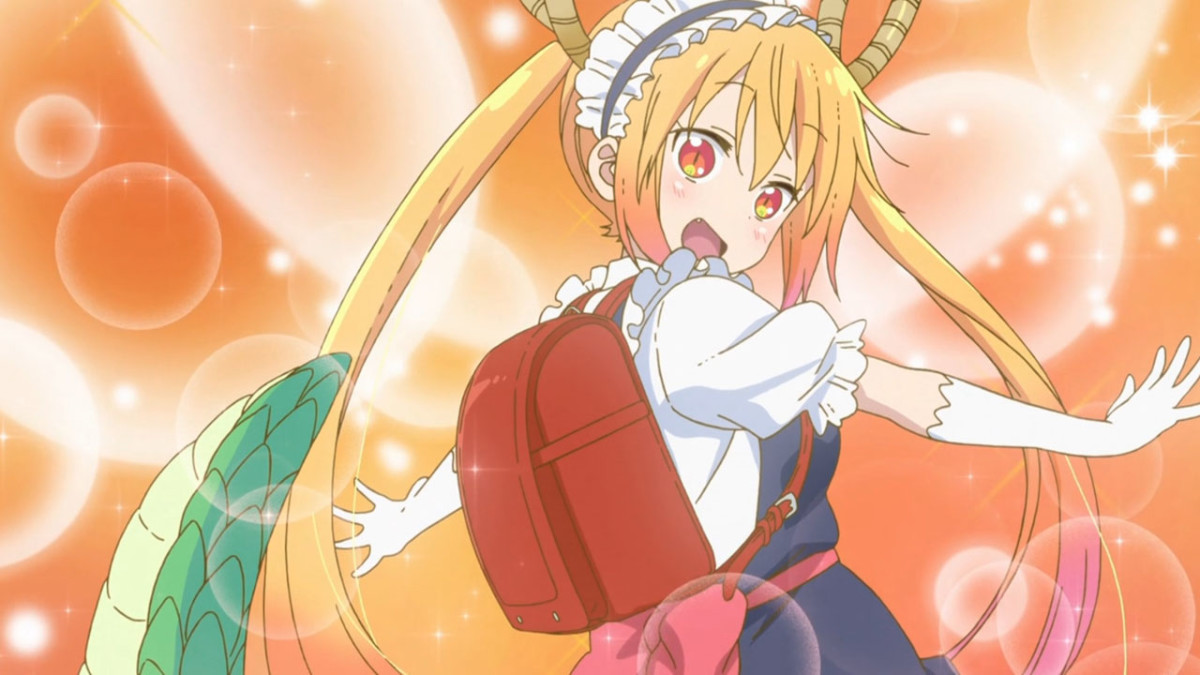
Anime has a knack for turning even the most fearsome creatures into endearing characters, and Miss Kobayashi’s Dragon Maid is a prime example of this delightful transformation. In this unique series, dragons take on the guise of shapeshifting girls, with the formidable Tohru finding herself working as a maid for the human Kobayashi.
Despite their unconventional circumstances, Tohru and Kobayashi forge a heartwarming and wholesome relationship as they navigate the ups and downs of daily life together. From humorous escapades to touching moments of camaraderie, their bond grows stronger with each passing episode.
The anime’s comedic flair shines through as the duo, along with other dragons, find themselves embroiled in a variety of entertaining shenanigans. Through it all, Miss Kobayashi’s Dragon Maid captures the essence of friendship, acceptance, and the beauty of finding connection in unexpected places.
With its blend of humor, heart, and fantastical elements, the series offers a refreshing and enjoyable viewing experience that leaves audiences eagerly awaiting each new adventure. As Tohru and Kobayashi navigate their unconventional relationship, viewers are treated to a charming tale of companionship and acceptance that resonates long after the credits roll.
“Miss Kobayashi’s Dragon Maid” (Kobayashi-san Chi no Maid Dragon) is a popular slice-of-life comedy anime series based on the manga of the same name by Cool-kyou Shinja. Produced by Kyoto Animation, the anime aired in 2017 and quickly gained a dedicated fanbase for its humor, heartwarming moments, and unique premise.
The story follows Kobayashi, an ordinary office worker living a mundane life until one night, after a drinking binge, she encounters a dragon named Tohru at the foot of a mountain. Tohru had taken a human form to interact with Kobayashi and offered to become her maid as a way of repaying a debt. Kobayashi, surprisingly unfazed by the situation, accepts her offer, leading to Tohru moving into her apartment as her dragon maid.
The series then explores the daily lives of Kobayashi, Tohru, and other dragon characters who gradually enter their lives, including Kanna, a young dragon girl who becomes like a daughter to Kobayashi, and other dragons from Tohru’s world who integrate into human society in various humorous and touching ways.
The characters in “Miss Kobayashi’s Dragon Maid” are vibrant and memorable, each adding their unique charm to the series. Kobayashi is portrayed as a practical and somewhat stoic woman who learns to appreciate the warmth and chaos that Tohru and the dragons bring into her life.
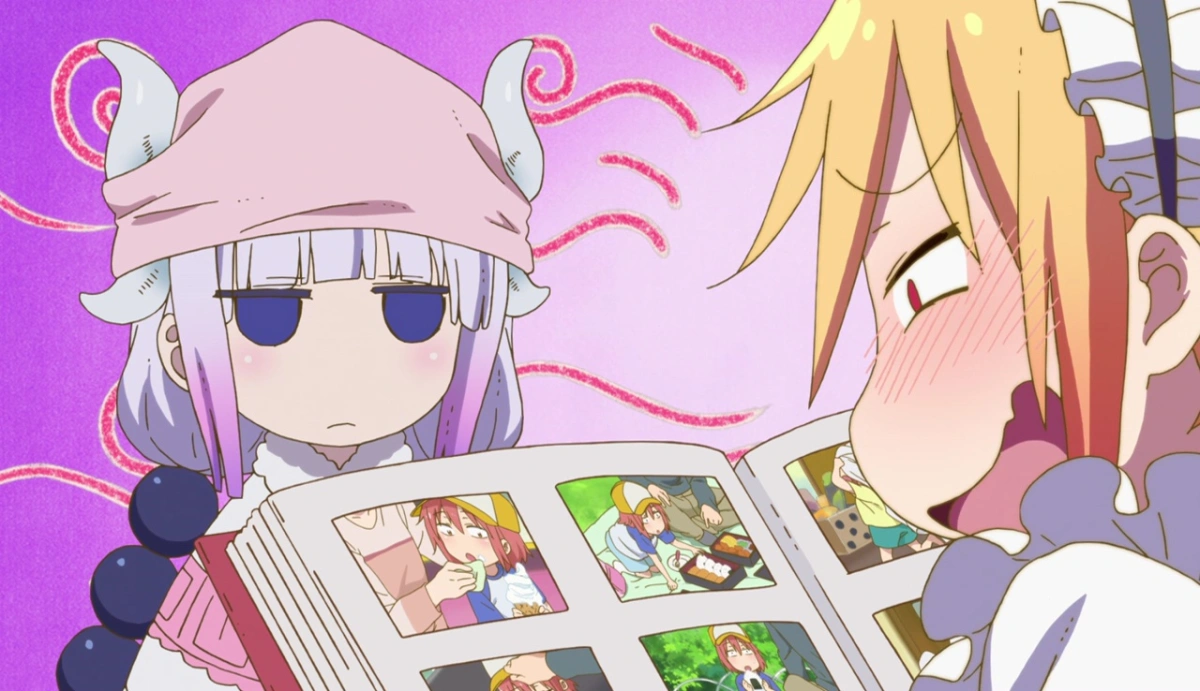
Tohru is devoted to Kobayashi and often tries her best to adapt to human customs, albeit in her own comical and over-the-top manner. Kanna, a fan-favorite character, is adorable and innocent, adding a lot of heart to the show with her interactions with Kobayashi and other characters.
Other dragons like Fafnir and Lucoa also bring their own eccentricities and comedic moments to the series, creating a lively ensemble cast with distinct personalities and dynamics.
At its core, “Miss Kobayashi’s Dragon Maid” explores themes of friendship, family, and acceptance. The series depicts how the unconventional relationships between humans and dragons develop into deep bonds filled with mutual understanding and affection. Through its humor and heartwarming moments, the anime emphasizes the importance of embracing differences and finding happiness in unexpected places.
Produced by Kyoto Animation, “Miss Kobayashi’s Dragon Maid” boasts high-quality animation characterized by fluid movements, expressive character designs, and richly detailed backgrounds. The art style is colorful and appealing, perfectly capturing the comedic and heartfelt moments of the series. The soundtrack complements the visuals with cheerful and whimsical tunes that enhance the atmosphere of the show.
The anime received positive reviews for its unique concept, endearing characters, and lighthearted storytelling. Critics and viewers alike appreciated its blend of comedy and heartwarming moments, as well as its exploration of themes such as friendship and acceptance. The series’ humor, particularly derived from the clash between the dragons’ supernatural nature and human society, resonated well with audiences.
Following the success of the anime, a second season titled “Miss Kobayashi’s Dragon Maid S” was released in 2021, continuing the story with new adventures and developments for the characters. Additionally, spin-off manga series and light novels focusing on specific characters like Kanna and Elma have expanded the franchise’s universe, further solidifying its popularity among fans.
In summary, “Miss Kobayashi’s Dragon Maid” is a charming and enjoyable anime that excels in its humor, character dynamics, and underlying themes of acceptance and friendship. Whether you’re drawn to its quirky premise, lovable characters, or heartwarming storytelling, the series offers a delightful and entertaining experience that has left a lasting impact on the slice-of-life genre.
4. Tanaka-kun is Always Listless

Apathy is indeed a common issue affecting many people, but in the world of anime, Tanaka-kun is Always Listless offers a refreshing and lighthearted take on the concept. While the idea of not finding joy in anything may lead to a serious narrative, this series opts for a more comedic approach.
Tanaka, the protagonist, epitomizes laziness in a humorous manner, providing plenty of laughs along the way. However, it’s the character of Ohta who truly shines as the heart of the show. His unwavering loyalty to Tanaka, despite his friend’s lack of enthusiasm, adds depth to the storyline. Watching their friendship grow and witnessing Ohta’s steadfast support for Tanaka creates a truly heartwarming tale that resonates with viewers.
“Tanaka-kun is Always Listless” (Tanaka-kun wa Itsumo Kedaruge) is a delightful slice-of-life comedy anime series adapted from the manga written by Nozomi Uda. Directed by Shinya Kawatsura and produced by Silver Link, the anime aired in 2016 and garnered praise for its laid-back humor, charming characters, and tranquil atmosphere.
The series follows the daily life of Tanaka, a high school student who epitomizes lethargy and laziness. Tanaka’s primary goal in life is to conserve energy and avoid any unnecessary exertion. He often daydreams about napping and is constantly seeking ways to minimize his efforts. His best friend, Ohta, is the complete opposite – responsible, reliable, and always looking out for Tanaka’s well-being.
The show unfolds in a typical high school setting, but what sets it apart is its focus on Tanaka’s amusing escapades as he navigates through life while striving to maintain his listless lifestyle. Despite his lethargy, Tanaka’s character exudes a certain charm that draws in the audience, making even the most mundane activities entertaining.
The characters in “Tanaka-kun is Always Listless” are endearing and relatable, each adding their own flavor to the series. Tanaka’s laid-back demeanor is complemented by Ohta’s supportive and caring nature. Ohta acts as Tanaka’s constant companion, often carrying him around to prevent him from overexerting himself. Their friendship forms the backbone of the show and provides a lot of the comedic moments.
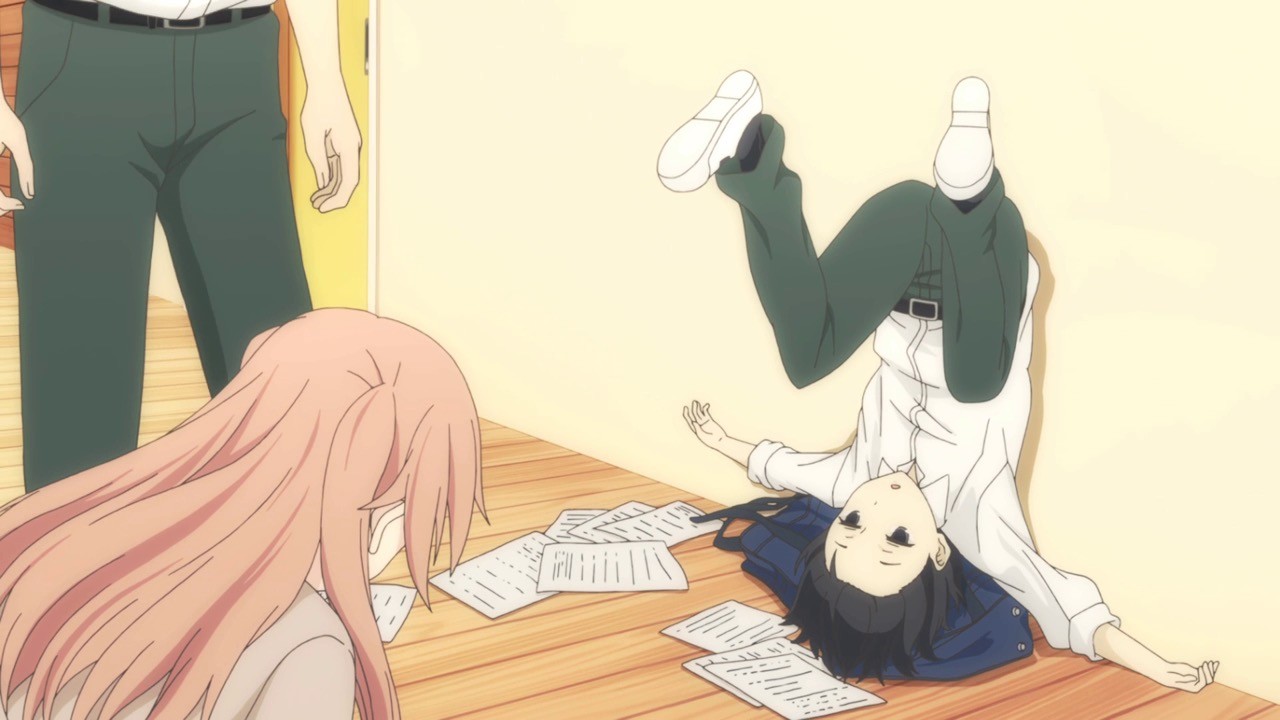
Other characters, such as Miyano, a bubbly girl who admires Tanaka, and Shiraishi, a talented but introverted student, further enrich the series with their interactions and unique personalities. The ensemble cast contributes to the show’s lighthearted and humorous atmosphere, creating a pleasant viewing experience.
At its core, “Tanaka-kun is Always Listless” explores themes of friendship, acceptance, and the importance of being true to oneself. Tanaka’s approach to life, while extreme, prompts viewers to appreciate the value of relaxation and simplicity amidst the busyness of daily routines. The anime adopts a gentle and whimsical tone, inviting viewers to slow down and enjoy the small pleasures of life alongside its characters.
The animation style of “Tanaka-kun is Always Listless” is characterized by soft colors, fluid movements, and expressive character designs. The laid-back nature of the series is reflected in its visuals, which contribute to its tranquil and soothing atmosphere. The soundtrack complements the tone with soothing melodies and cheerful tunes that enhance the comedic and contemplative moments of the show.
The anime received positive reviews for its unique premise, likable characters, and refreshing take on the slice-of-life genre. Critics and viewers appreciated its humor, character dynamics, and ability to find comedy in everyday situations. The series’ relaxed pacing and genuine charm resonated well with audiences looking for a light-hearted and feel-good anime experience.
Tanaka-kun is Always Listless is a charming and enjoyable anime that stands out for its laid-back humor, endearing characters, and tranquil atmosphere.
Whether you’re seeking a relaxing slice-of-life series or a lighthearted comedy with memorable characters, this anime offers a delightful escape into the world of Tanaka’s listless adventures. With its simple yet engaging storytelling, “Tanaka-kun is Always Listless” is a gem that invites viewers to slow down, unwind, and appreciate life’s simple pleasures.
3. Bocchi the Rock!

Social anxiety is undoubtedly a challenging topic to tackle in anime, yet Bocchi the Rock! manages to do so with aplomb. The series revolves around Hitori Goto, who harbors dreams of becoming a rockstar despite her crippling shyness. However, with the unwavering support of her friends, Hitori learns to confront her fears and pursue her passion for music.
What sets Bocchi the Rock! apart is its portrayal of Hitori’s journey towards overcoming social anxiety. Despite her timid nature, Hitori possesses remarkable talent as a rockstar, needing only a stage and a boost of confidence to shine. The anime’s blend of humor and heartfelt storytelling has garnered praise, with its writing hailed as some of the best in the genre.
As viewers accompany Hitori on her quest for self-discovery, they are treated to a narrative that celebrates friendship, perseverance, and the power of pursuing one’s dreams. Through its relatable characters and engaging storyline, Bocchi the Rock! offers an uplifting and inspiring experience that resonates with audiences of all ages.
“Bocchi the Rock!” (or “Bocchi the Rock”) is a manga series written and illustrated by Aki Hamaji. It began serialization in the magazine Weekly Shonen Magazine in December 2020. The series falls under the genres of comedy, drama, and music, and it has gained attention for its unique premise and engaging characters.
“Bocchi the Rock!” follows the story of Saku Ogura, a high school girl who loves rock music and dreams of forming her own band. Despite her passion for music, Saku has never played any instruments or performed publicly.
One day, she meets a mysterious girl named Bocchi, who turns out to be an incredibly talented guitarist but is also socially awkward and struggles to communicate with others.
Encouraged by Bocchi’s musical talent and determination, Saku decides to take the lead and form a band with Bocchi as the guitarist. The series chronicles their journey as they recruit other members, face challenges, and strive to achieve their dreams of becoming a successful rock band.
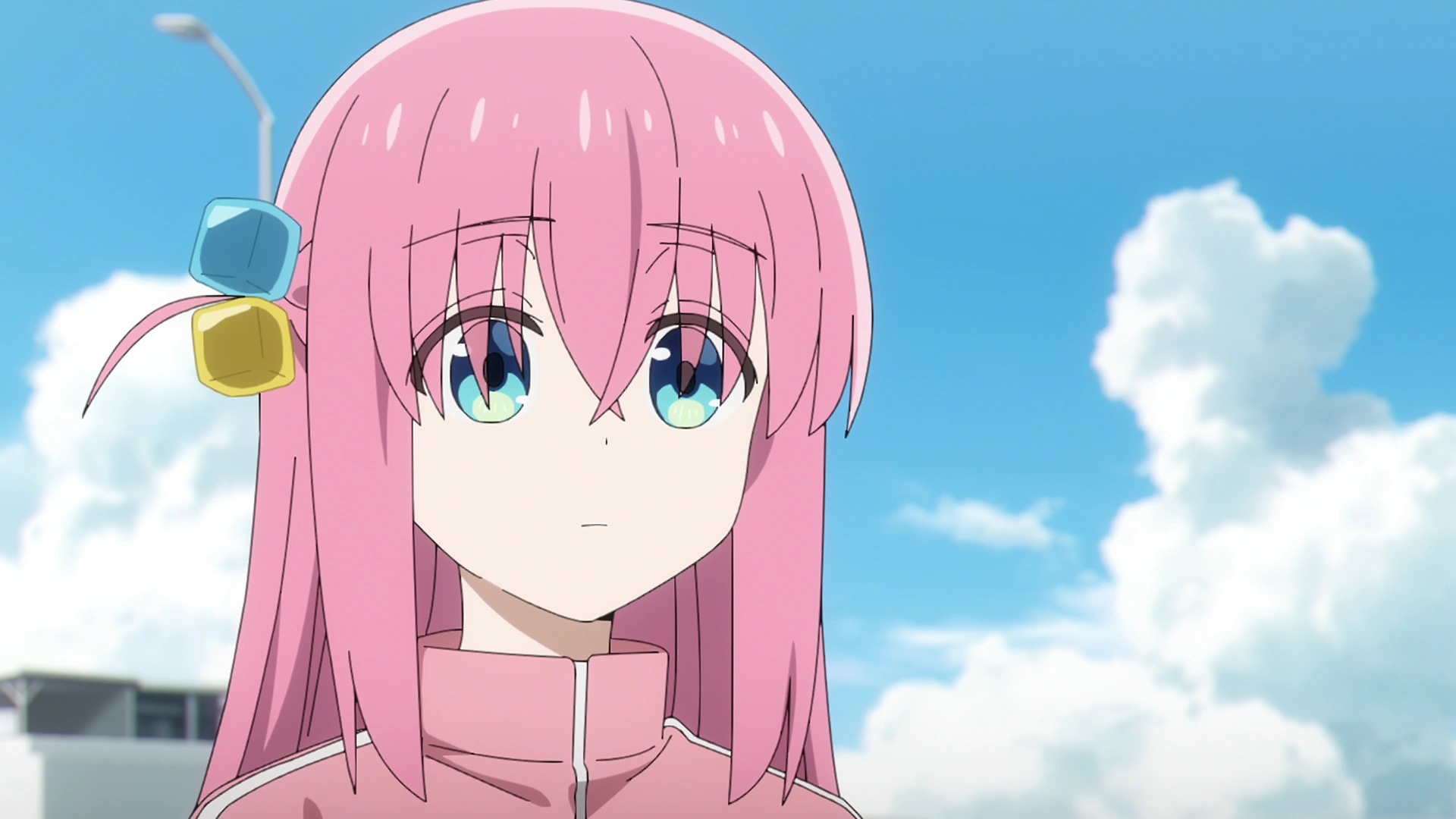
At its core, “Bocchi the Rock!” explores themes of friendship, perseverance, and the pursuit of dreams. The series goes into the challenges faced by individuals pursuing creative endeavors and highlights the importance of teamwork and mutual support in overcoming obstacles.
The tone of the manga is a blend of comedy and drama, with lighthearted moments interspersed with more emotional and introspective scenes. The characters’ growth and development as they navigate the music industry and build relationships with each other form the heart of the story.
Aki Hamaji’s artwork in “Bocchi the Rock!” is expressive and dynamic, particularly during music performances and intense scenes. The character designs are distinct and memorable, reflecting their personalities and roles within the story. The manga effectively captures the energy and passion of rock music through its visuals.
“Bocchi the Rock!” has received positive feedback from readers for its engaging storyline, likable characters, and thematic depth. Fans of music-themed manga appreciate the series’ focus on the creative process and the challenges faced by aspiring musicians. The manga’s ability to balance humor with emotional moments has contributed to its popularity among readers.
Bocchi the Rock!” is a compelling manga series that follows the journey of a group of young musicians as they pursue their dreams of forming a rock band. With its well-developed characters, thematic depth, and energetic artwork, the manga offers an enjoyable and uplifting reading experience.
Whether you’re a fan of music-themed stories or looking for a manga with relatable characters and engaging plotlines, “Bocchi the Rock!” is worth checking out for its blend of comedy, drama, and heartfelt storytelling.
2. Komi Can’t Communicate

Komi Can’t Communicate struck a chord with audiences, quickly becoming a massive sensation thanks to its simple yet heartwarming premise and lovable characters. Viewers were drawn to the wholesomeness of the interactions and the gradual development of Komi, who evolves into a charming and endearing character with the help of her supportive friends.
The series delicately addresses social anxiety, a topic that resonates with many viewers. Through Komi’s experiences, the anime sheds light on the challenges of communication and the feelings of isolation that often accompany social anxiety. However, Komi finds solace in the genuine friendships she forms along the way, as her friends stand by her side and encourage her to overcome her struggles.
Despite the attention Komi receives due to her communication difficulties, she finds comfort in the companionship of those who genuinely care for her well-being. Together, they navigate the ups and downs of social interactions, showcasing the importance of empathy, understanding, and acceptance.
With its relatable themes and heartwarming moments, Komi Can’t Communicate serves as a source of inspiration and comfort for viewers, reminding them that they are not alone in their struggles and that true friendships can help overcome even the most daunting challenges.
*Komi Can’t Communicate* (also known as *Komi-san wa, Komyushou desu.* in Japanese) is a popular manga series written and illustrated by Tomohito Oda. It was first serialized in Shogakukan’s *Weekly Shōnen Sunday* magazine in 2016 and has since gained a significant following both in Japan and internationally. The series has been praised for its charming characters, unique premise, and heartfelt storytelling.
The story revolves around Shoko Komi, a high school girl who is admired by her classmates for her beauty and perceived elegance. However, behind her aloof demeanor lies a secret—Komi suffers from extreme social anxiety, which renders her unable to communicate effectively with others. Despite her desire to make 100 friends, she struggles to initiate conversations or express herself verbally.
One day, Tadano Hitohito, a kind and average high school boy, discovers Komi’s secret when she unintentionally asks him for help. Realizing her struggle, Tadano makes it his mission to help Komi achieve her goal of making friends. He becomes her first friend and acts as her communication partner, facilitating interactions with various classmates who gradually come to appreciate Komi for who she is.
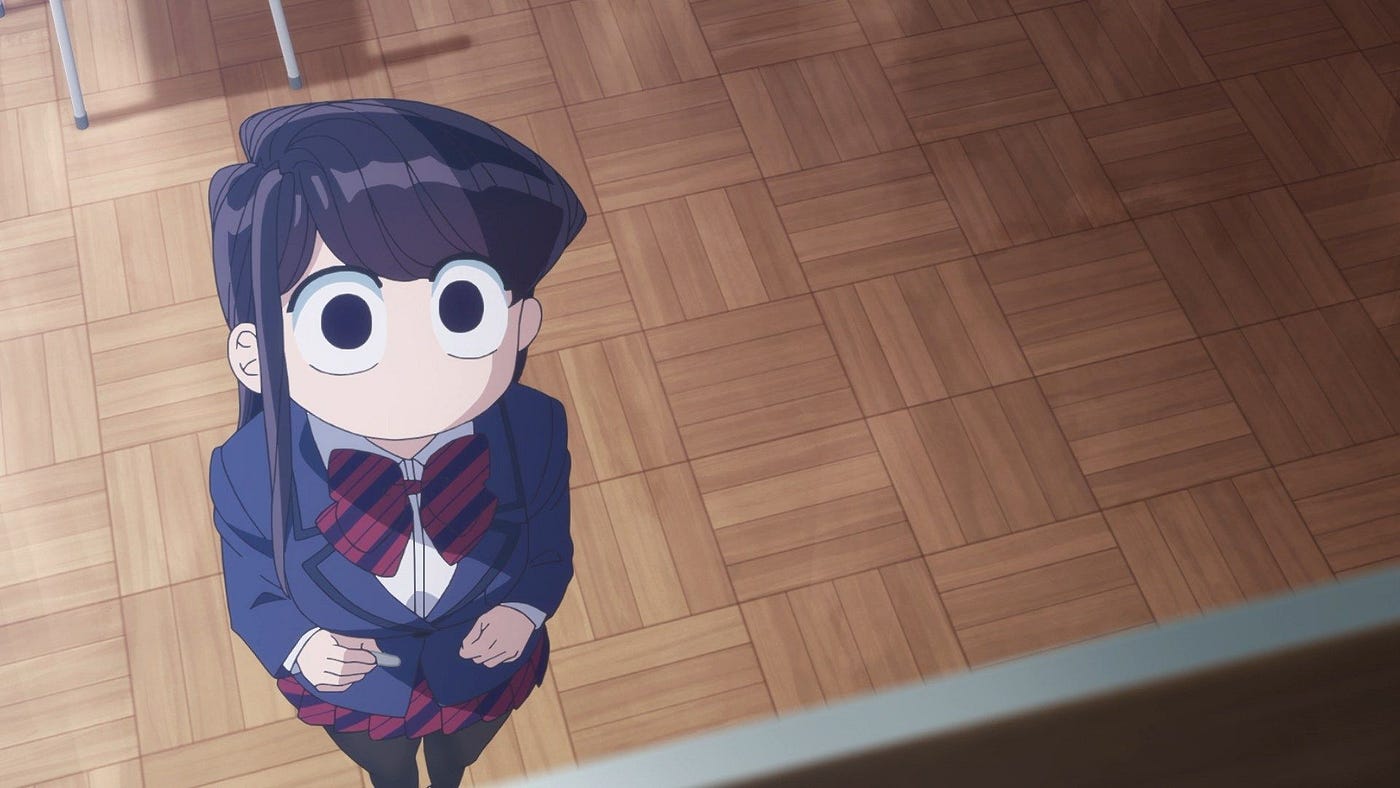
Characters
- Shoko Komi: The protagonist of the series, Komi is a beautiful and reserved girl who suffers from social anxiety. Despite her difficulties in communication, she is kind-hearted and earnestly desires to make friends.
- Tadano Hitohito: A down-to-earth and empathetic boy who befriends Komi and supports her in her quest to make friends. He serves as her interpreter and helps bridge the gap between Komi and her classmates.
- Najimi Osana: A cheerful and eccentric classmate of Komi who identifies as non-binary. Najimi is determined to help Komi make friends and often comes up with creative strategies to facilitate social interactions.
- Other Classmates: Throughout the series, Komi encounters a diverse range of classmates, each with their own quirks and personalities. As the story progresses, many of these characters befriend Komi and play integral roles in her growth.
*Komi Can’t Communicate* explores themes of friendship, acceptance, and self-discovery. It highlights the challenges of social anxiety and the importance of genuine human connections. The series balances comedic moments with touching character development, making it relatable to readers of all ages.
The manga has received widespread acclaim for its endearing characters and relatable narrative. Komi’s struggles resonate with many readers who have experienced similar feelings of social isolation or anxiety. The relationship between Komi and Tadano is particularly praised for its sincerity and emotional depth.
Tomohito Oda’s artwork is clean, expressive, and visually appealing. The character designs are distinctive, with Komi’s elegant appearance contrasting with Tadano’s more ordinary look. The manga effectively conveys emotions through facial expressions and body language, enhancing the storytelling.
In addition to the manga, *Komi Can’t Communicate* has been adapted into various media formats. An anime adaptation premiered in October 2021, bringing the characters and story to life through animation. The anime received positive reviews for its faithful adaptation and charming presentation.
*Komi Can’t Communicate* is a heartwarming and insightful manga that resonates with readers through its relatable characters and themes. It explores the challenges of social anxiety with empathy and humor, offering a message of hope and encouragement.
Whether you’re a fan of slice-of-life stories, comedy, or character-driven narratives, *Komi Can’t Communicate* is a delightful series that is well worth experiencing. It’s not only entertaining but also carries a meaningful message about the importance of friendship and understanding.
1. Bunny Drop

Recent entertainment media has certainly emphasized the emotional depth brought by the parent-child dynamic, and Bunny Drop stands out by focusing solely on this relationship without any other distractions.
The story follows Daikichi, who reluctantly takes on the role of a father to Rin, a young girl he unexpectedly becomes responsible for. As they look on their journey together, viewers witness Daikichi’s transformation into a caring and devoted father figure and the heartwarming bond that forms between him and Rin.
The anime is filled with memorable experiences shared between Daikichi and Rin, each moment adding to the charm and appeal of their relationship. From heartfelt conversations to hilarious mishaps, these interactions form the heart of Bunny Drop, fascinating audiences and endearing them to the duo.
Bunny Drop offers a simple yet wholesome viewing experience, perfect for fans seeking a heartwarming story centered on the parent-child dynamic. Through its sincere portrayal of familial love and the joys of parenthood, the anime resonates with audiences of all ages, leaving a lasting impression long after the credits roll.
*Bunny Drop* (Usagi Drop) is a touching and heartwarming manga series written and illustrated by Yumi Unita. Originally serialized from 2005 to 2011 in the magazine *Feel Young* by Shodensha, it has garnered critical acclaim for its realistic portrayal of family dynamics and emotional storytelling.
The story begins with 30-year-old bachelor Daikichi Kawachi attending his grandfather’s funeral. At the funeral, Daikichi discovers that his late grandfather had a young illegitimate daughter named Rin Kaga, who is just 6 years old. Rin is seen as an embarrassment by the family due to her illegitimate status, and no one is willing to take her in.
Feeling compassion for Rin’s plight, Daikichi decides to take responsibility for her and becomes her guardian. The series follows Daikichi’s journey as a single parent, navigating the challenges of raising Rin while balancing his work and personal life. The heartwarming bond that develops between Daikichi and Rin forms the core of the narrative.
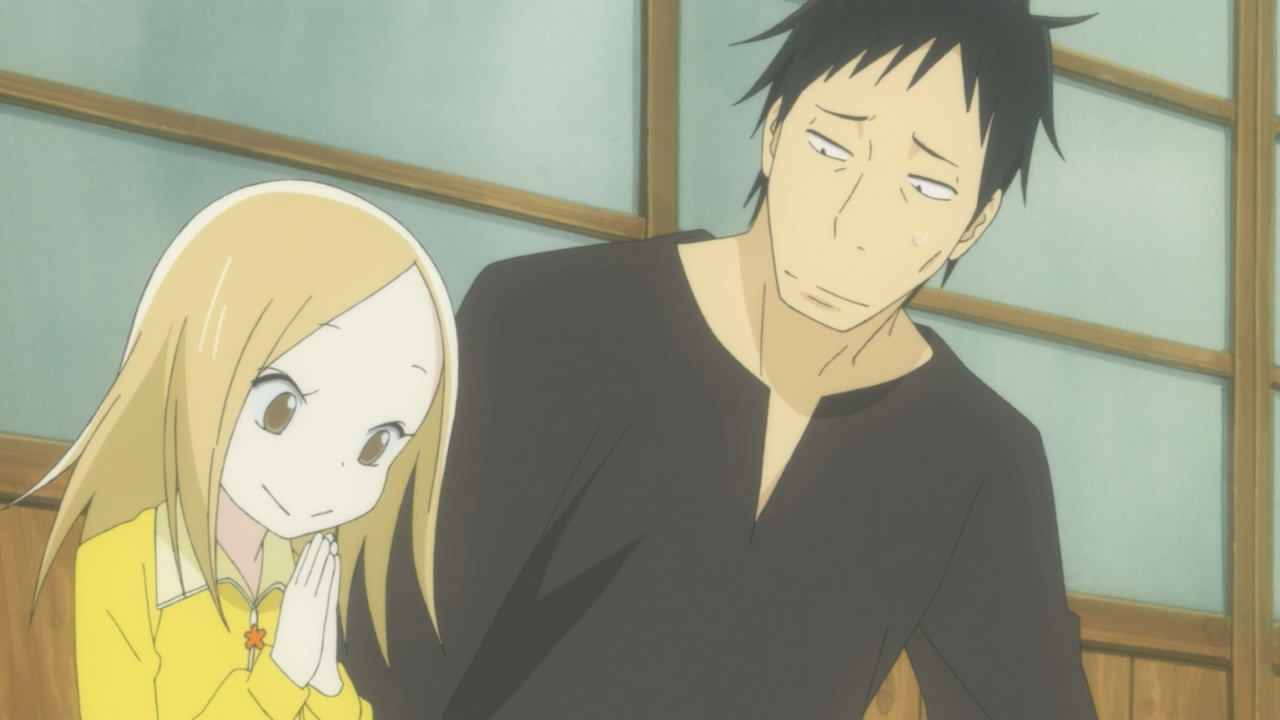
Characters:
Daikichi Kawachi: The protagonist of the series, Daikichi is a kind-hearted and responsible man who unexpectedly becomes a father figure to Rin. He is portrayed as down-to-earth and caring, often putting Rin’s needs above his own.
Rin Kaga: A quiet and observant 6-year-old girl who is Daikichi’s aunt (although she calls him “Dai-chan”). Rin is initially shy and reserved due to her difficult upbringing but gradually opens up under Daikichi’s care.
Other Characters: Throughout the series, various characters—including Daikichi’s family members, colleagues, and friends—provide support and contribute to Rin’s upbringing, offering insights into different aspects of parenthood and family life.
Bunny Drop explores themes of family, parenthood, sacrifice, and personal growth. It depicts the challenges and joys of raising a child as Daikichi navigates the responsibilities of parenthood without prior experience. The manga is characterized by its gentle and heartfelt tone, emphasizing everyday moments and small gestures that deepen the bond between Daikichi and Rin.
Yumi Unita’s artwork in *Bunny Drop* is clean, detailed, and expressive. The character designs are simple yet distinctive, capturing the emotions and nuances of each character effectively. The manga’s panel layout and pacing contribute to the intimate and slice-of-life feel of the story.

*Bunny Drop* received widespread critical acclaim for its realistic portrayal of family dynamics and its poignant exploration of parenthood. The manga was particularly praised for its sensitive handling of themes such as adoption and the complexities of familial relationships.
However, it’s worth noting that the reception of the series became somewhat divided towards the latter part of its run due to certain narrative developments. Without spoiling specifics, some readers felt that the story took unexpected directions that diverged from the tone established in the earlier chapters.
In addition to the manga, *Bunny Drop* was adapted into an anime series in 2011, which faithfully adapted the first half of the manga’s storyline. The anime adaptation received positive reviews for its emotional resonance and character-driven narrative.
*Bunny Drop* is a poignant and introspective manga that explores the transformative power of family and parenthood. Through its relatable characters and heartfelt storytelling, it invites readers to reflect on the meaning of familial bonds and the joys of nurturing relationships.
While the series has garnered acclaim for its early chapters, opinions may vary regarding its later narrative developments. Nonetheless, *Bunny Drop* remains a memorable and thought-provoking work that resonates with readers looking for a sincere exploration of family life and human connections.
Meme of The day
NCP Harem Haramase Kyoudan 3

Soha Yang – Questism Pixiv

Pixiv 117941131
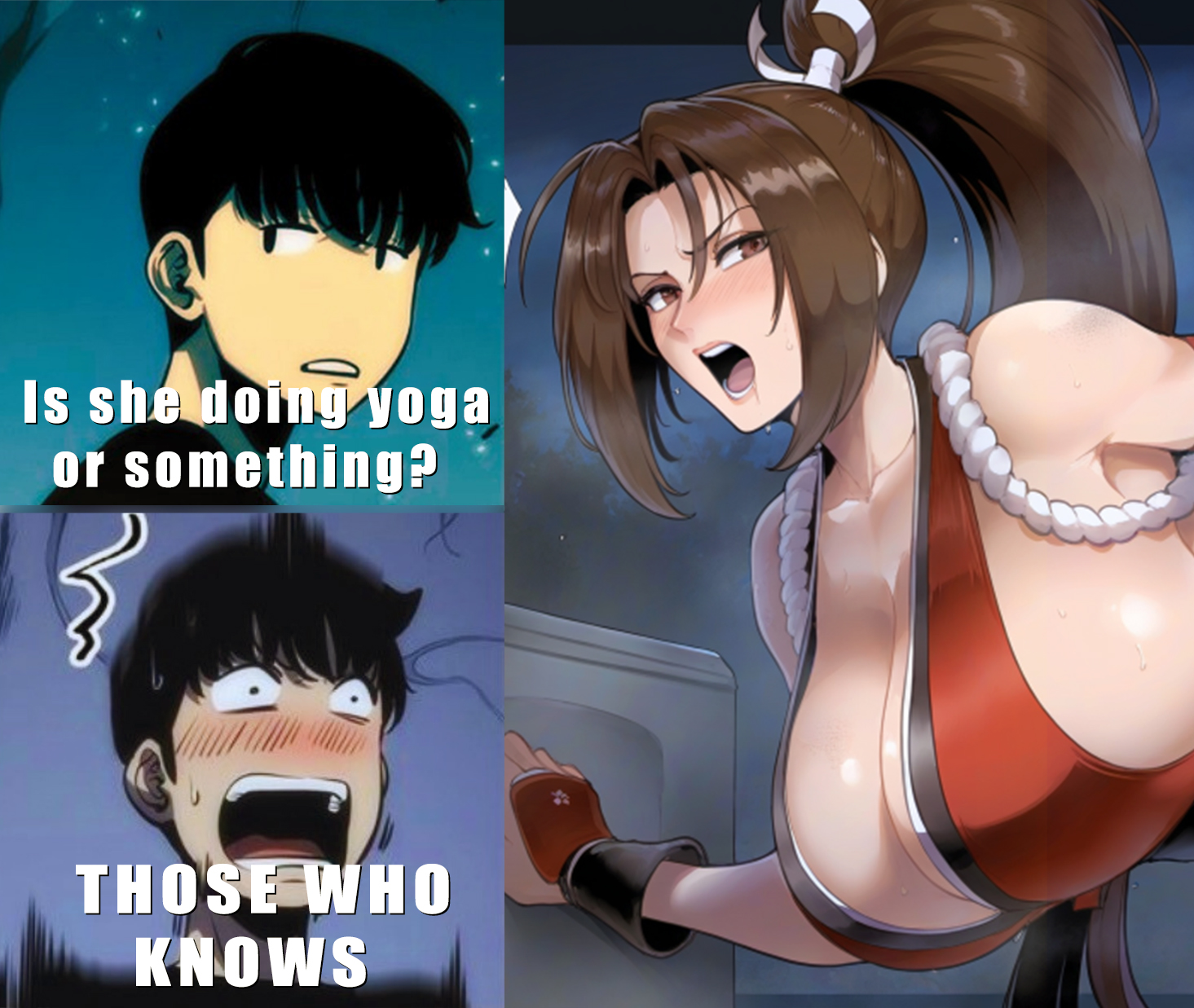
Jujutsu Kaisen & CSCT-012

Infinite Stratos

Sauce: 464344
Iu wa Katashi Okonau wa Yasushi | Easier Done Than Said [Okyou]
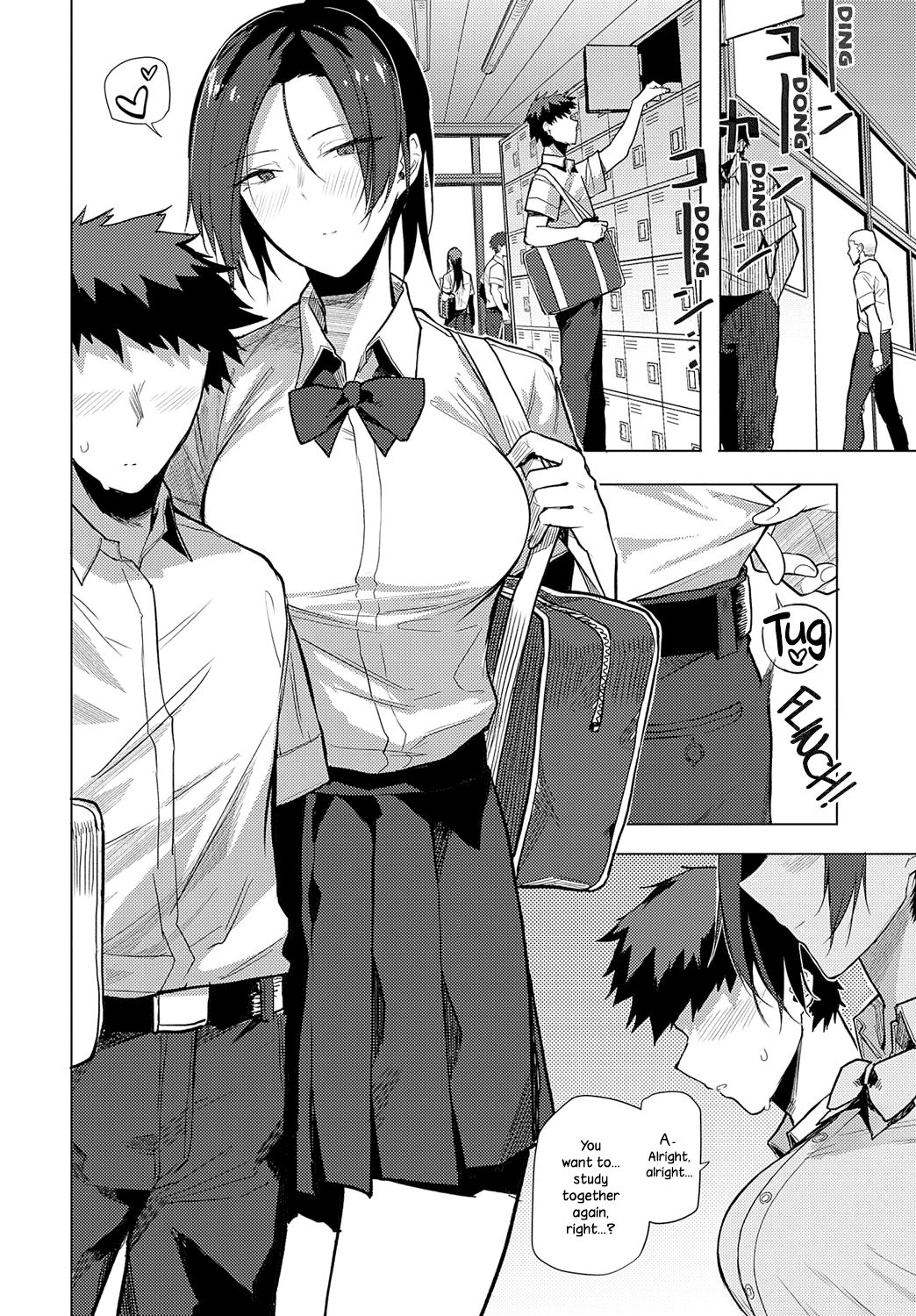
Isekai Fall of the Hero
